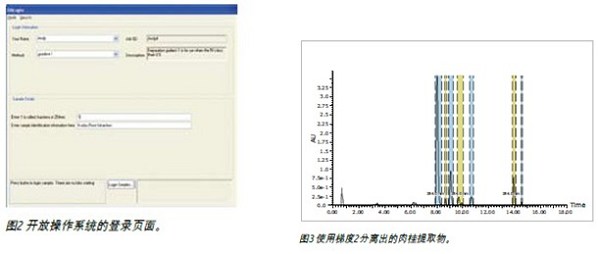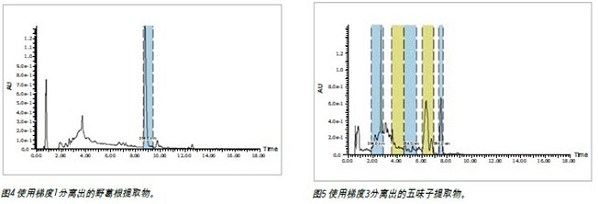Preparation of natural product extracts using an UV-guided open-operation purification strategy
Andrew Aubin, Ronan Cleary and Darcy Shave
Waters Corporation, Milford, MA, US
Application benefit
This application note describes techniques for assisting chemists in simplifying the selection of raw material extract purification methods through an open-operated purification system. In contrast to a general method for various extracts, a simple method selection criteria (based on thin layer chromatography analysis) allows the separation method to be tailored to the particular extract. This allows the chemist to reduce the number of reanalysis and repurification steps; ultimately speeding up the entire purification process.
Waters Solutions
Component-based preparative HPLC module
MassLynxTM software
FractionLynxTM and Open Operations Application Manager
SunFireTM C18 Preparation Column Based on OBDTM Technology
Key words
Schisandra, Cinnamon, Kudzu, Open Operation, Preparative Chromatography, FractionLynx Application Manager
introduction
The extraction of pharmaceutically active compounds from plant material can be achieved by a number of different methods. Finally, the chemist gets a raw material extract containing the potentially active compound mixed with other inactive ingredients. After extraction, the next step is to purify or isolate those target compounds. Preparative liquid chromatography is often used to accomplish this task. Compounds that may be extracted have large differences, so performing a full purification requires different chromatographic methods to achieve efficient separation. Therefore, open-operated LC systems that offer chemists a variety of methods are worthwhile. Analytical methods can vary in column size, run time, gradient conditions, solvents, modifiers, and other variables. These options make it difficult for chemists to select the best method for their extracts and delay the separation and development of the target compound.
To help each chemist simplify the process of selecting the appropriate first-test method for his extract, this article describes an open operating system that uses a simple method selection criteria (based on thin-layer chromatography).
Chemists can better obtain higher purity compounds by using separation methods tailored to their extracts. Instead of using a common method for all extracts, the chemist can radically reduce the number of reanalysis and repurification steps by selecting the appropriate method, which ultimately speeds up the process.
experiment
Sample and extraction
This experiment extracted three different plant materials: Schisandra Chinenis, Cinnamomum Zeylanicum and Pueraria lobata. Ten grams of the dry sample was added to a 50 mL methanol/water mixture having a volume ratio of 60:40, and shaken for 1 hour. The extract was centrifuged; then the clear extract after centrifugation was used directly. No attempt was made to optimize the extraction process.
Thin layer chromatography (TLC)
The extract was separated using a mixture of n-hexane and ethyl acetate on a 5 x 20 cm TLC silica gel plate (Partisil LK6F silica gel 60A and a fluorescent indicator, Waterman, Maidstone, UK). Visualization of the sample was achieved by exposing the chromatograph to ultraviolet light and observing the spots. The specific shift value is derived from these observations.
Preparative liquid chromatography
Preparative HPLC analysis using a Waters 2545 Quaternary Gradient Module, Model 2489 UV/Vis Detector, Preparative Chromatography Rack, and Fraction Collection Based on SunFire Prep C18 OBD Column (5 μm, 19 x 100 mm) The system consisting of III. The entire system is controlled using MassLynx software with both FractionLynx and an open-mode application management program. Table 1 summarizes the process parameters, mobile phase components, and gradient conditions as shown on page 3.
Results and discussion
To simplify the process of deciding which separation method should I use, the user must first collect some sample information. Ideally, a series of analytical grade HPLC separations will be performed first, and then the preparative method will be derived, formed, and scaled up based on these results. In many cases, this complex process is time consuming and unnecessary. This is especially true when multiple extracts are processed at once in the initial stages of the study. A simpler method is available for performing an initial evaluation based on thin layer chromatography, evaluating the results, and designing a suitable preparative liquid chromatography method based on the calculated shift ratio of the target compound. In this case, the extract was first analyzed by thin layer chromatography as shown in Figure 1. The user can design a method with specific separation characteristics based on the analysis results of thin layer chromatography or use a method that has been designed in an HPLC system, as shown in FIG.



To further streamline the HPLC purification process, the method selection can be simplified using only the login page of the open operating system, as shown in Figure 2. When the login button is checked, the user can easily perform the injection through the manual injector. After the test run is complete, the results can be printed or emailed to the user. These gradients are designed to ensure that even if the user chooses a poor method, all potential target compounds can be eluted from the column and collected. An example of this can be seen in Figure 3, which shows the cinnamon extract separated using Gradient 2. Two compounds with very late elution times were collected for a longer period of time after the thin layer chromatography target compound.

Figures 4 and 5 show extracts of Pueraria lobata and Schisandra chinensis isolated using the techniques described. The chromatograms of these three natural product extracts are similar to those obtained with thin-layer chromatography plates, indicating that this technology provides a suitable workflow. Once the analysis is complete, the sample results can be emailed to the user or printed out as needed. The system administrator can determine login access permissions, method selection, and report generation to complete system configuration and setup. The system administrator can also increase or decrease the number of available methods for analyzing the selection. The Model 2545 Quaternary Gradient Module allows the selection of four solvents simultaneously, which offers the possibility of selecting multiple buffers or alternative organic modifiers. The preparative chromatography rack accommodates multiple columns and a pair of injectors for added flexibility.

As a final confirmation of the system function, the fraction collected from the Pueraria lobata extract was reanalyzed using an analytical HPLC system, as shown in FIG. The results show that the pure single peak of the Pueraria lobata is isolated and collected, which can be used in subsequent development steps.
in conclusion
â– Waters' open operating system allows chemists to analyze samples prior to preparation by simply walking to the LC system, logging in sample information, injecting, and leaving several steps.
â– Method parameters can be customized to meet individual laboratory workflow requirements.
â– Optimize the collection of potentially active compounds by presenting a variety of methods for a chemist.
â– By using a method tailored to its compounds, chemists can accelerate the speed of the research process by taking higher quality fractions from the mixture in the shortest possible time.
About Waters Corporation ( )
For more than 50 years, Waters Corporation (NYSE: WAT) has made significant advances in medical services, environmental management, food safety and global water quality monitoring by providing practical and sustainable innovations that have created business for laboratory-related organizations. Advantage.
As a pioneer in a range of separation science, laboratory information management, mass spectrometry and thermal analysis technologies, Waters technology's breakthroughs and laboratory solutions create a lasting platform for customer success.
With $1.64 billion in revenue and 5,400 employees in 2010, Waters will continue to lead customers around the world to explore science and achieve excellence.
Imported Premium Flexibilizer
Toughening agent refers to the material that can increase the flexibility of adhesive film. Some thermosetting resin adhesives, such as epoxy resin, phenolic resin and unsaturated polyester resin adhesives, have low elongation and high brittleness after curing. When the adhesive parts bear external forces, they are easy to crack and rapidly expand, resulting in cracking of the adhesive layer, fatigue resistance, and can not be used for structural bonding. Therefore, we must try to reduce brittleness, increase toughness, improve the bearing strength. Any material that can reduce brittleness and increase toughness without affecting other major properties of the adhesive is a toughening agent. It can be divided into rubber toughening agent and thermoplastic elastomer toughening agent.
Imported Premium Flexibilizer,Imported Premium Abs Plastic,Premium Polyamide Resin,Imported Premium Mbs
Xingbang High Molecular Materials Co., Ltd. , https://www.chemicaladditive.com





